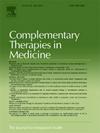每日鼻内滴注芝麻油改善鼻屏障功能和粘膜免疫对呼吸系统健康的影响:一项健康成人的随机试验
IF 3.5
3区 医学
Q1 INTEGRATIVE & COMPLEMENTARY MEDICINE
引用次数: 0
摘要
鼻屏障功能和粘膜免疫对呼吸系统健康至关重要,特别是随着越来越多的证据表明空气污染对健康的影响。美国本土,传统的中国和印度医学系统推荐鼻内滴油呼吸健康。我们评估了每日鼻内滴注油改善呼吸系统健康的可行性、可接受性和初步疗效。方法采用平行组三臂随机对照试验(RCT),将健康志愿者(n = 102)平均分配至鼻内芝麻油、药物芝麻油(Anu oil)和对照组,验证其可行性和可接受性。通过评估编码鼻屏障功能的粘蛋白基因MUC5B、MUC5AC的表达来检测其初步疗效。其他结果包括Occludin (OCLN), Claudin 9 (CLDN9)和Junction Adhesion Molecules (JAM)的表达,细胞因子(IL6, IL10, TNF α, IFN γ),鼻粘液pH值,粘膜免疫(sIGA),睡眠质量,感知应激以及呼吸道感染的发生率和严重程度。结果在印度浦那招募和保留参与者(平均年龄20.6岁)是可行的。99名参与者完成了这项为期12周的研究。无严重不良事件发生。我们标准化了使用Whatman (no.42)试纸条无创收集鼻黏液样本的方法及其处理以优化RNA产率。除了无法检测到JAM和IFN γ的表达外,结果评估是可行的。MUC5B和MUC5AC的下调和细胞因子水平未同时升高表明鼻内滴注油有潜在的有益效果,并确保了安全性,尽管在本试验中不显著。芝麻油组患者睡眠质量(组差[∆]= - 1.33,p = 0.02)和鼻pH值(∆= - 0.16,p = 0.01)均有显著改善。解释:本研究证实了自行鼻内注入香油的可行性和初步疗效。需要一个明确的随机对照试验来评估它作为呼吸系统健康的预防措施。本文章由计算机程序翻译,如有差异,请以英文原文为准。
Daily intranasal sesame oil instillation to improve nasal barrier function and mucosal immunity for respiratory health: A pilot randomized trial in healthy adults
Background
Nasal barrier function and mucosal immunity are important to respiratory health, especially with growing evidence of health effects of air pollution. Native American, Traditional Chinese and Indian medicine systems recommend intranasal oil instillation for respiratory health. We assessed feasibility, acceptability, and preliminary efficacy of daily intranasal oil instillation for improved respiratory health.
Methods
A parallel group three arm randomized controlled trial (RCT) in healthy volunteers (n = 102) allocated equally to intranasal sesame oil, medicated sesame oil (Anu Oil) and control groups tested its feasibility and acceptability. Preliminary efficacy was tested by assessing expression of mucin genes (MUC5B, MUC5AC) that code for nasal barrier function. Other outcomes included expression of Occludin (OCLN), Claudin 9 (CLDN9) and Junction Adhesion Molecules (JAM), cytokines (IL6, IL10, TNF alpha, IFN gamma), pH of nasal mucus, mucosal immunity (sIGA), sleep quality, perceived stress, and incidence and severity of respiratory infections.
Results
Recruitment and retention of participants (Mean age= 20.6years) in Pune, India was feasible. Ninety nine participants completed this 12-week study. There were no serious adverse events. We standardized methods for noninvasive collection of nasal mucus samples using Whatman (no.42) paper strips and its processing to optimize RNA yield. Assessment of outcomes was feasible except for expression of JAM and IFN gamma that were undetectable. Downregulation of MUC5B and MUC5AC and no concurrent rise in cytokine levels suggest potential beneficial effect and assure safety of intranasal oil instillation, though nonsignificant in this pilot RCT. Significant improvements in sleep quality (group difference [∆] = −1.33, p = 0.02) and nasal pH (∆ = −0.16, p = 0.01) were found in sesame oil group.
Interpretation
Feasibility and preliminary efficacy of self-administered intranasal sesame oil instillation is demonstrated. A definitive RCT to evaluate it as a prophylaxis for respiratory health is needed.
求助全文
通过发布文献求助,成功后即可免费获取论文全文。
去求助
来源期刊

Complementary therapies in medicine
医学-全科医学与补充医学
CiteScore
8.60
自引率
2.80%
发文量
101
审稿时长
112 days
期刊介绍:
Complementary Therapies in Medicine is an international, peer-reviewed journal that has considerable appeal to anyone who seeks objective and critical information on complementary therapies or who wishes to deepen their understanding of these approaches. It will be of particular interest to healthcare practitioners including family practitioners, complementary therapists, nurses, and physiotherapists; to academics including social scientists and CAM researchers; to healthcare managers; and to patients. Complementary Therapies in Medicine aims to publish valid, relevant and rigorous research and serious discussion articles with the main purpose of improving healthcare.
 求助内容:
求助内容: 应助结果提醒方式:
应助结果提醒方式:


